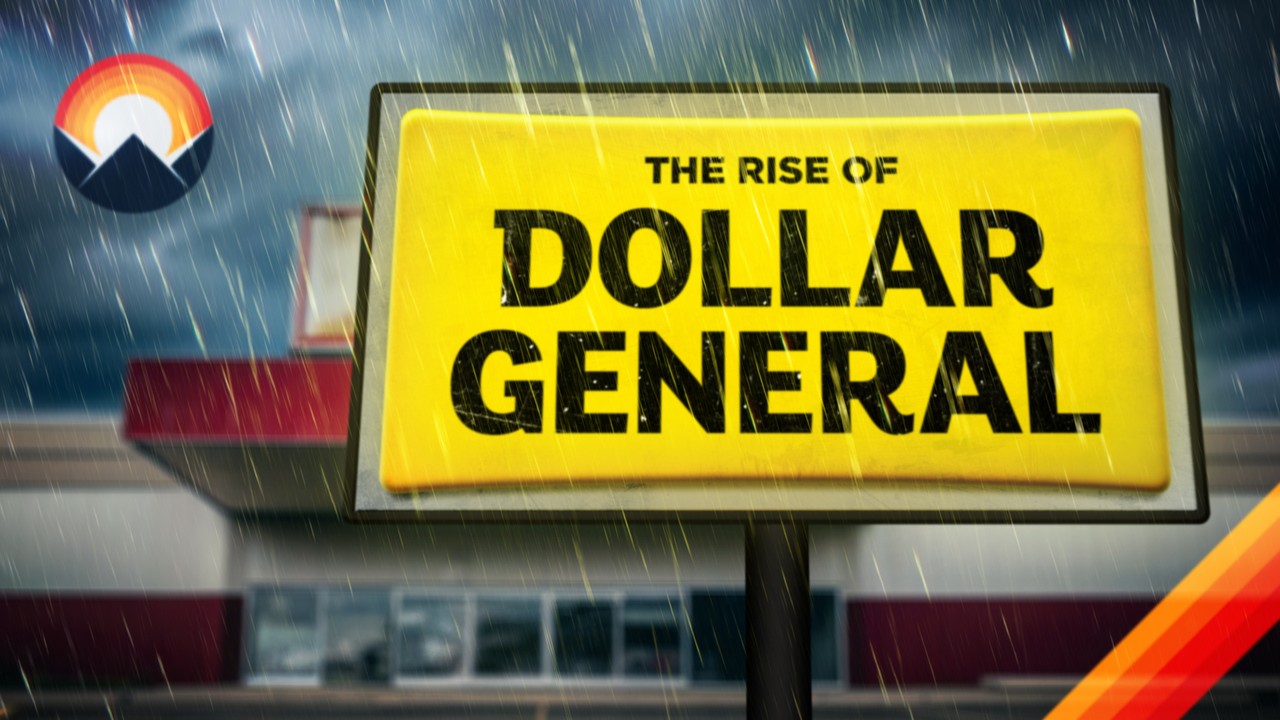Not from the US and not super familiar with dollar stores, so/but this was a fascinating watch. Terrible how they drive independent grocers out of business in small towns and their role in urban food deserts is interesting and horrifying.
I can’t imagine having no access to fresh food. I live in a European city and in a 500 meter radius I probably have ten places where I can buy some sort of vegetable, fruit, dairy product, fresh bread, etc. Not to mention countless restaurants where I can also eat.
What I did wonder: in poor urban areas in the US, are there no small shops catering mostly to immigrants? In most places I’ve lived there are quite a few smaller shops that have products (including produce) from specific regions where many residents of the area are from. So like a Turkish bakery or some shop run by Colombians I sometimes go to that has plantains and queso fresco and stuff. I would think that especially in the US with so many immigrants you would have loads of those kinds of shops.
I live in a European city and in a 500 meter radius I probably have ten places where I can buy some sort of vegetable, fruit, dairy product, fresh bread, etc.
In my American city, in a 500 meter walking distance there’s literally nothing but single-family houses, churches, and a school. It is prohibited by law for there to be anything else! (I say “walking distance” instead of “radius” because there are stores on the other side of the freeway, but if you can’t get to them they don’t count, right?)
What I did wonder: in poor urban areas in the US, are there no small shops catering mostly to immigrants?
Sure, if there are allowed to be (see previous paragraph). Otherwise, shops catering mostly to immigrants have to be located on the main stroad and poor immigrants have got to drive to them just like everybody else. (Or take one of the private bus services that sometimes exist to cater to those areas.)
in poor urban areas in the US, are there no small shops catering mostly to immigrants?
I grew up in a city where most of my peers qualified for free or reduced school lunches.
There were no immigrant shops because there were few to no immigrants. None of the major grocery stores were even in the city limits because they were evading city taxes. It was only a 10-15 minute drive, but that requires you to have a car. The smaller local grocery stores in my neighborhood pretty much all closed shop between the 80s & 00s, and they had already been gone from other neighborhoods before then. They were also always more expensive than the larger stores, but, again, those required driving.
There are local stores catering to different immigrant populations where I am now, but there are populationz to support them. They would still require a car to get to.
I think one thing to keep in mind is how absolutely MASSIVE the US is – even the smallest state in the US is larger than a handful of European countries.
It’s very common for people to live a 30+ minute drive from cities and/or their workplace, and in these more rural areas, it can be unsustainable to open small shops, because of reduced traffic…and people are shopping at the “super centers” in the city.
I think one thing even more important to keep in mind is how completely irrelevant the US’s massive size is. It doesn’t fucking matter that there are empty states out west or long distances between cities; the vast majority of people still live within metro areas and that’s not any different from Europe.
“ThE uS IS a MasSIvE cOUnTrY” is nothing but a massive American-exceptionalist copout.
Edit: to be clear, I’m not trying to attack @neopenguin in particular here. It’s just that lots of people make that ignorant argument, and like the guy who created the video I linked, I’m sick and tired of seeing it. Stop upvoting ignorance!
You’re right on this one.
It’s so tiring for people to keep repeating this annoying "fac"t that the US is big hence all the poor zoning. It’s irrelevant. It’s a cop out.
Most food deserts are found in urban areas, where most people live.
The size of the US is very important when discussing food deserts, including within urban limits. Many cities are not friendly to pedestrians and are set up so you have to drive to the commercial centers to get food. When you couple that with poor public transportation, it doesn’t make it easy to get fresh food. Mixed use areas are also not as common, since residential and commercial zoning keeps stores out of residential areas.
Like, I have something like 8 grocery stores within 10 miles of me, but there’s almost no sidewalks in either direction, and in one direction, you’re walking on highway to get there, which isn’t safe.
Also, a four hour roundtrip to a grocery store isn’t really feasible when you also have work, kids, chores, etc.
Looking at the London metro area, Google tells me that it’s about 600 square miles with a population of 9 million. For comparison, Detroit Metro area is almost 1.2K square miles with a population of 3.7 million. Houston is 10K square miles with a population of 7.1 million
So yeah, the size of the US is definitely a factor in food deserts. Outside of maybe NYC metro area (4.6k square miles with 20.1 million people), we just don’t have the population density in most of our urban areas.
These Dollar General arguments never leave any doubt as to who lives in a city and who lives in the boonies.
the vast majority of people still live within metro areas
But when we talk about food deserts, that’s not where we’re talking about. We’re not talking about the vast majority. We’re talking about the other 20%, or 66 million Americans, who live in rural areas and who get a Dollar General instead of an Wegman’s.
“Despite the increase in the urban population, urban areas, defined as densely developed residential, commercial, and other nonresidential areas, now account for 80.0% of the U.S. population” - https://www.census.gov/newsroom/press-releases/2022/urban-rural-populations.html
But when we talk about food deserts, that’s not where we’re talking about. We’re not talking about the vast majority. We’re talking about the other 20%, or 66 million Americans, who live in rural areas and who get a Dollar General instead of an Wegman’s.
On the contrary, we’re very much talking about urban areas, because food deserts very much include urban areas.
I myself lived in a food desert until recently, despite the fact that my neighborhood is so urban I could easily ride my bike to the state capitol building. I had a choice of several supermarkets each about 2 miles away, but none within a mile until a new one opened a year or so ago.
Yeah that’s a fair point and I understand this is the case in more rural areas, but what about Atlanta like discussed in the video? There you would have loads of people living in a certain area and although they might not have a lot of money, wouldn’t their desire to buy the foods and products of where they’re from be a lifeline for these small shops?
In many European cities there are supermarkets but also smaller greengrocers, also (or even especially) in poorer neighbourhoods with a high immigrant population.
I don’t understand why the economics for those shops would be different in the US and why you wouldn’t have them in less economically developed areas in cities such as Atlanta. Perhaps because dollar stores don’t really exist here, but here they need to compete with bigger supermarket chains that do operate in all parts of the city.
Yeah that’s a fair point and I understand this is the case in more rural areas, but what about Atlanta like discussed in the video? There you would have loads of people living in a certain area and although they might not have a lot of money, wouldn’t their desire to buy the foods and products of where they’re from be a lifeline for these small shops?
Atlantan here. Best I can do is this.
That’s one of many ethnic shopping centers along the stroad called Buford Highway, which is the corridor along which many of the metro area’s Latino and Asian folks live.
I don’t understand why the economics for those shops would be different in the US and why you wouldn’t have them in less economically developed areas in cities such as Atlanta. Perhaps because dollar stores don’t really exist here, but here they need to compete with bigger supermarket chains that do operate in all parts of the city.
There’s a Family Dollar and a Dollar Tree within a mile of this location.
The other thing about the US is the missing middle. We don’t have a lot of medium density housing. There is a focus on single family homes because the car industry was so successful at convincing everyone and politicians that everyone needed a car. Ironically, now we all need cars because everything is spread out. Even big cities like Atlanta, Denver, Detroit, etc… have a ton of urban sprawl and low density. Our cities just aren’t nearly as walkable and sense as others.
I think a lot of it comes down to when you’re struggling as many people are, what happens a few years down the line doesn’t matter as much as do I have enough to get by today. And then if you manage to make it through today, you have to worry about tomorrow because that’s gonna become today real soon.
Fresh vegetables and fruits can be a fantasy when you’re trying to feed a family on a single income and have to figure out how to do it for five dollars.
I was lucky growing up, we were lower middle class but lived in the country and my dad had a huge vegetable garden and if it was winter we could afford fresh vegetables (I also really love veggies so even canned tastes good to me).
But my girlfriend grew up and her mom struggled with three daughters and her dad was useless. My girlfriend was convinced she didn’t like vegetables except sweet corn because as sad as it is she didn’t get a chance to try any that were cooked correctly and didn’t come out of a can. Guess who loves Brussels sprouts now?
I’m in suburban Minneapolis, Minnesota and have at least four different small grocers within 500m. At 2km, I have at least four supermarkets and dozens of smaller options. Minnesota is also weird in how much fresh produce gas stations have because no one wants to make two stops in winter. Overall, Dollar General is actually pretty uncompetitive comparatively.
Atlanta is an outlier because of low population density. Additionally, the poor in Atlanta are brutally poor. Income disparity is pretty crazy. $5.15 is the state minimum wage.
Not that it really matters because both are obscenely low, but national minimum wage is like 7.35, so that’s the lowest it can be.
Only for employers subject to FLSA. Tipped employee minimum wage is $2.13.
Yeah, but anything short of the 7.35 has to be made up by the employer.
They might desire it, but it may not be enough to convince grocery stores to open up there.
The is another video that Wendover did about grocery stores in general and most of the country has consolidated to a few major chains with massive supply chains backing them up. It is really hard to compete with them on price.
Some major cities have bodegas which fill this role, but relations between bodegas and the communities they serve can be strained as bodegas charge higher prices for lower quality produce, in part because they don’t have access to the grocery store supply chains.
In rural areas, there is only really the economy for one or two grocery stores. Dollar General can enter a town of that size, something that Walmart couldn’t do. There isn’t the market diversity for an immigrant grocery stores.
This very thing happened in the town I grew up in. Dollar General moved in and no more than five years later the local grocery store, which had been there since the 60’s, closed down. Pretty sad really. Now residents have to drive 20mims to the next town over to get fresh fruit/veggies/meats. I’m honestly glad I moved away to a bigger city.
Not sure if this is just a unique experience for me but I’ve always grown up needing like at least 15 minutes to do a grocery shopping trip. In college it would take 30 minutes to bus to the grocery store. Maybe my experience is rare? I just consider trips that take 30 minutes or less to the grocery store not that bad especially since you only need to do it once or twice a week.
For some reason, my town decided to open a second Dollar General 1.3 miles away from the first one.
They aren’t expensive to build and run, so they are probably going to build to market saturation.
Love the city clickers in these threads calling DG the devil. I clearly see the harm in placing them in cities. But I can clearly see the benefit of placing them in the boonies. Guarantee that any replies to this post will tell me exactly which locale that person lives in. Hint: You won’t find us rural people bitching about a new DG moving in.
I’m on the very edge of town and the new DG was a godsend. 6-miles to a mildly overpriced supermarket. I can walk to DG faster. Plus, there are a lot of poor people here who can’t afford cars. You’ll see them walking and biking with DG bags everywhere. What else are they to do?
“But they’re killing rural mom-and-pop stores!”
Are they? All I see in the countryside is a DG with nothing else around for miles and miles and miles.
Funny anecdote on that; I have a camp outside Holt, FL, pop. 2,400 (and that covers a lot of ground).
There are exactly 2 places to purchase goods, mom-and-pop gas station/general store and DG. The home-grown store is in zero danger, they’re jam packed.
Come take a 12-hour drive through the South’s back highways with me, let’s see what you think.
Tell me you didn’t watch the video without telling me you didn’t watch the video lol
deleted by creator




